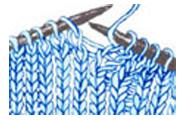 Knit Stitch (k st) is made by putting the needle through the
back of the stitch from right to left. Knit Stitch (k st) is made by putting the needle through the
back of the stitch from right to left.
How to Knit :
 Cast on 20 stitches for practice. Hold needle with cast on stitches in the left hand. Hold second needle and yarn from skein in right hand. The yarn from skein should be in back of the needles. Cast on 20 stitches for practice. Hold needle with cast on stitches in the left hand. Hold second needle and yarn from skein in right hand. The yarn from skein should be in back of the needles.
 Insert right needle into front of first stitch under the left needle Insert right needle into front of first stitch under the left needle
 Wind yarn from your right hand under and over point of needle. Wind yarn from your right hand under and over point of needle.
Draw right needle and yarn through stitch.
 Slip the stitch just made off left needle. One knit stitch made. 'Slip' in knitting means -move (a stitch) to the other needle without stitching it. Slip the stitch just made off left needle. One knit stitch made. 'Slip' in knitting means -move (a stitch) to the other needle without stitching it.
 Repeat in each stitch across until all the stitches
have been knitted off left needle. Push work along left needle so the stitch to
be worked is near tip. At the end of row, turn work so needle with stitches is
in the left hand. Continue working rows of knit stitch in this manner until you
are familiar with this stitch. Repeat in each stitch across until all the stitches
have been knitted off left needle. Push work along left needle so the stitch to
be worked is near tip. At the end of row, turn work so needle with stitches is
in the left hand. Continue working rows of knit stitch in this manner until you
are familiar with this stitch.
When you knit each stitch in each row it is
called Garter stitch.
Top
To Bind Off :
 When you have finished
a swatch, you must learn to 'bind off' to hold it together. It is necessary to bind off in knitting to prevent the
stitches from raveling. It should be done rather loosely. Slip the first stitch
off the left needle onto the right needle without knitting it. Knit the next
stitch. Insert the left needle through the front of the first stitch on the
right needle and slip it over the second stitch, bringing the right needle and
second stitch through the first stitch. When you have finished
a swatch, you must learn to 'bind off' to hold it together. It is necessary to bind off in knitting to prevent the
stitches from raveling. It should be done rather loosely. Slip the first stitch
off the left needle onto the right needle without knitting it. Knit the next
stitch. Insert the left needle through the front of the first stitch on the
right needle and slip it over the second stitch, bringing the right needle and
second stitch through the first stitch.
Then slip the first stitch off left needle. One
stitch is left on the right needle. Knit next stitch and slip preceding one over
it.
Continue across until you come to the last stitch.
Cut yarn about 5 inches from needle. Draw loose end through last stitch and pull
to tighten. Thread end into a needle and work end back through edge. Cut off
close to work.
Top
 How to Increase (inc): How to Increase (inc):
To increase on a knit row, knit the stitch in the
usual manner but do not slip the stitch off the left needle. Knit again in the
same stitch by inserting the needle into the back of the stitch. Now slip the
stitches off the needle.
Top
 How to Decrease
(dec): How to Decrease
(dec):
To decrease on a knit row, knit two stitches together
by inserting the right needle through two stitches.
Top
 To make a Yarn Over
(yo): To make a Yarn Over
(yo):
Yarn over increases a stitch and is used in lace patterns since it produces a hole in the work. On a knit row, bring yarn under tip of right needle, up and over needle, then work next stitch. |


